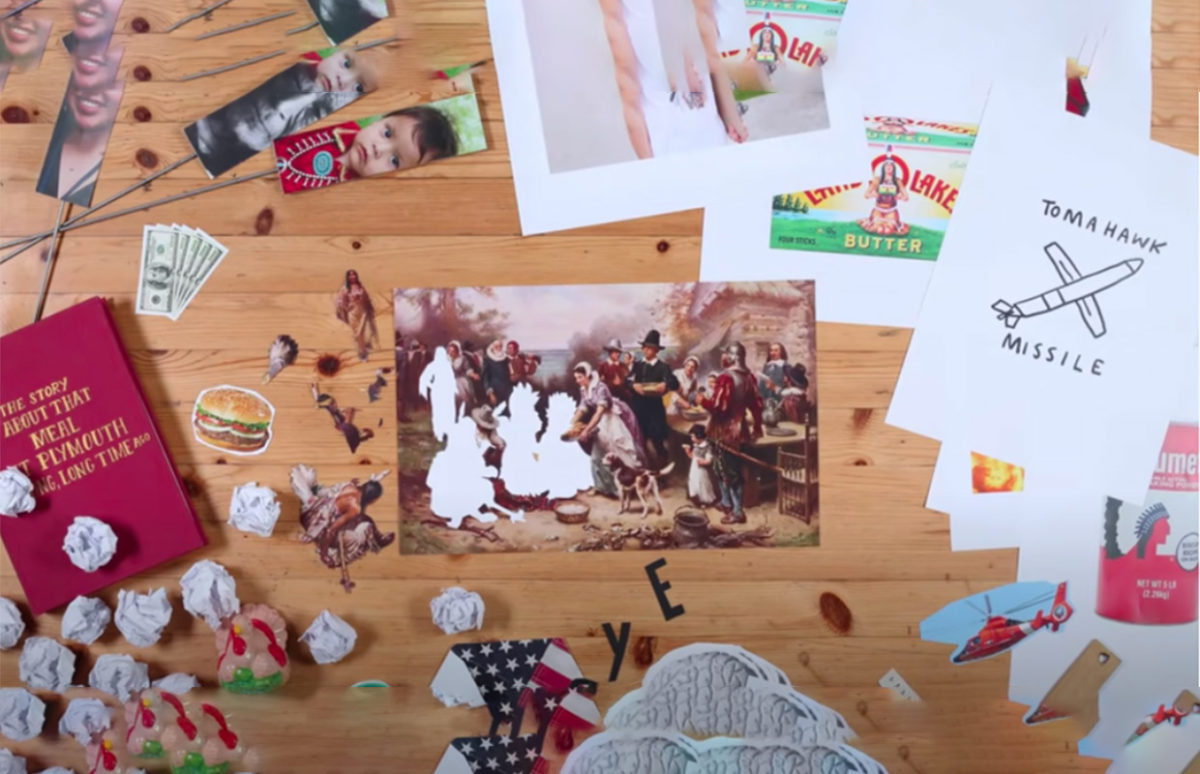Today, there is growing awareness that the "Thanksgiving story" told to young schoolchildren in the U.S.A., which provides much of the traditional imagery of the holiday, is just that: a story. Many Native Americans denounce the hypocrisy of portraying this origin story of the nation as a peaceful and cooperative meeting of peoples, when in reality it was a disaster for Native people, who would be decimated and dispossessed of their land and traditions.
In this interview, Paul Chaat Smith, who is Comanche and curator of the Smithsonian Museum of the American Indian, offers a different take on the Native representation in the Thanksgiving myth and popular culture. He argues that it is better to be misrepresented rather than whitewashed out of the picture altogether and calls for efforts to come up with a new, better way to celebrate Thanksgiving.
There is a lot of text onscreen and visual imagery to help comprehension. In fact you may want to play the video without sound first, to allow pupils to pick up information from the text and images. For comprehension, from B1, you may want to skip the part about Thanksgiving today, to 1:41 "So, eventually the country ended up deciding..."
This video was recorded in connection with a beautiful exhibition at the Museum of the American Indian, much of which you can view online. It explores why images and stories of "Indians" are so pervasive in American popular culture. It features stories about Pocahontas, the Indian Removal Act and Battle of Little Big Horn as well as "The Invention of Thanksgiving."
Transcript:
Interviewer: Alright. So, what is Thanksgiving?
Paul Chaat Smith: Thanksgiving is insane. It’s this huge, incredible disaster of highways and airports, and it’s crowded, and the weather’s awful. A meal that takes days, sometimes weeks of preparation. Emotional turmoil. Fights.
But, the fact that it’s a national holiday that really envelops everyone, it’s this sense of the entire country in motion in a way that isn’t really like any other day in American life.
And the way it’s corny, it’s cartoonish, and kitsch is kind of a protective layer to sort of not get too direct about it.
So underneath all those things Thanksgiving is about trying to come to terms with this very difficult truth about the United States. That the country is a national project that came about at great expense to Native people.
And, it’s not enough that we’re a good country. We kind of have to be the best country, you know. But Native people and African slavery, those two things together are huge challenges to how you process this.
So, eventually the country ended up deciding you know what, we like the story about that meal at Plymouth, a long, long time ago in which these newly arrived people from England in this new country had their brunch in the forest, with Indians.
And what was that saying? That was saying, you know, we’re neighborly. We want this to work out. And we know it didn’t all work out. But that’s what we aspire to be. That’s sort of our best selves.
Interviewer: Did that meal actually happen?
Paul Chaat Smith: It happened, but nobody really cared. It wasn’t like, “Oh, remember that time last November? Let’s have those folks over again. Fire up the grill.” Nobody thought that, because it was just a thing that happened. But the Pilgrim folks there, they were writing letters, they were writing journals, they were like really meticulously detailing what was happening.
But, even that written account gets lost for basically two hundred years, and doesn’t even emerge until the 1840s, when this document is discovered again. And even then it’s not a big deal. It’s actually in a footnote. And we remember that, we rescue it from being a footnote because that has meaning now.
And so, by the early 20th century, Indians are an indivisible part of what creates the United States. It’s not a chapter that happened and was bad and we got over it. We’re in your head. We’re in your pantry. We’re in your garage. This imagery, representations, advertising, Thanksgiving says, however imperfectly we remember Indians, we’re remembering Indians.
And, with all the problems with it it’s still a powerful idea, and it’s still powerful to not Photoshop Indians out of the national narrative. To say, “We’re owning this.” And there’s a way that can open up ways to start thinking about it differently, opens up for people to become activists, and try to change things, invent some new kind of Thanksgiving. Let’s have the discussion, let’s see where that goes.
But before you get to the lessons and is it right to use that? Is it whatever? I don’t know. I guess if I were to put myself in terms of, you know this, a cartoon Indian and all this at Thanksgiving, I’d probably be saying "I’m glad to be here." Better than the alternative.
Copyright(s) :
Smithsonian
> Sur la piste des Sioux : the origins of “American Indian” iconography
> Thanksgiving Dinner in Space
> Thanksgiving on the Web
Tag(s) : "Indians" "Native American" "November" "Smithsonian" "thanksgiving" "U.S.A." "United State" "video"






